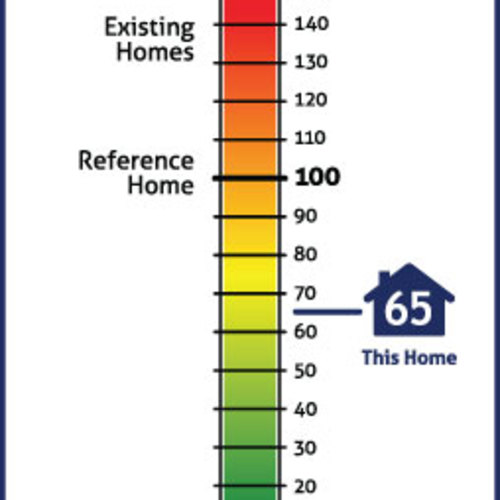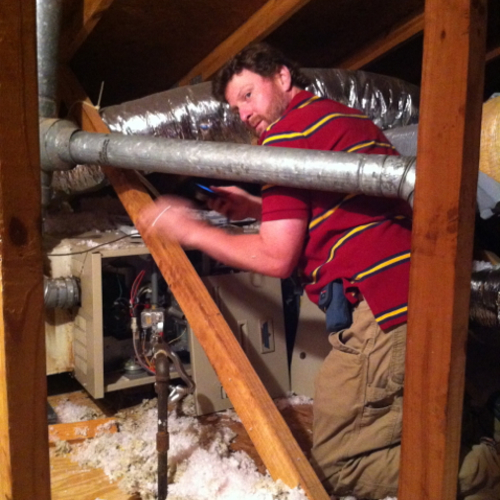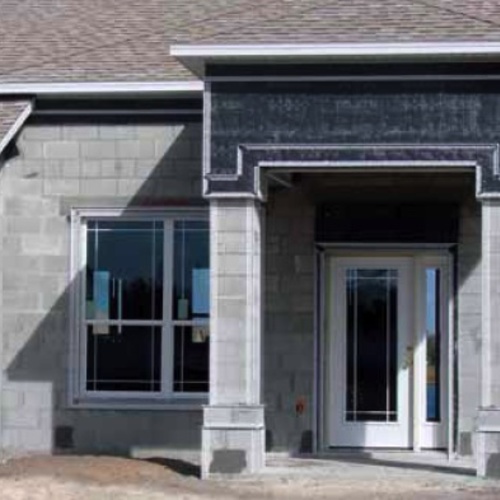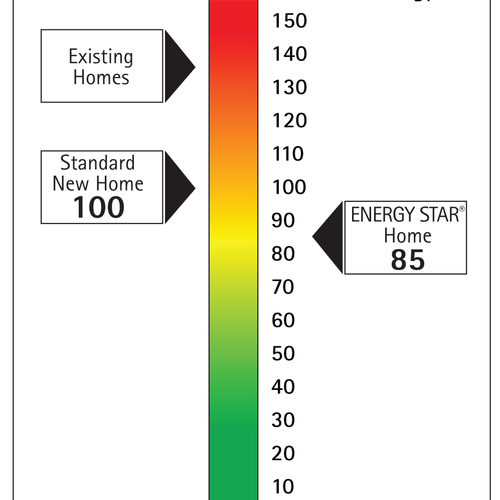
Image Credit: Residential Energy Services Network’s
The Residential Energy Services Network’s Home Energy Rating System, known as the HERS Index, continues to advance in the marketplace. So far, more than 60 state and regional builders have committed to marketing the HERS Index scores of the homes they build, according to RESNET’s list of partners.
One of the newest to join the list is the Illinois division of the largest builder in the U.S., D.R. Horton.
RESNET, which announced the agreement with Horton on October 6, calls the companies that market their homes’ HERS Index scores RESNET Energy Smart Builders, a distinction intended to highlight the homes’ energy performance – and the reliability of HERS scores – to prospective buyers.
HERS raters collect energy performance data about the home they’re testing and compare it to that of an imaginary reference home of the same size and shape. The reference home is “built” to barely meet the 2006 International Energy Conservation Code. A RESNET-approved computer program calculates the energy efficiency of the home being tested and indexes it to the reference home, which is assigned a HERS score of 100. The lower the HERS score of the tested home, the more energy efficient it is.
Building the HERS Index brand
HERS Index scores do seem to be among the simplest and most concise ways of describing a home’s energy performance to prospective buyers. A number of builders, including production builder KB Home, and other energy-focused agencies, such as the Department of Energy, have come up with “mileage stickers” to help highlight the energy efficiency performance of homes in simple terms. Some stickers use a HERS Index score to tout performance. Some, such as the DOE Home Energy Score and Earth Advantage Institute, cite estimated BTUs used annually. The DOE also has created an EnergySmart Home Scale sticker that features estimated gas and electric usage as well as comparative HERS Index ratings. KB Home’s Energy Performance Guide includes both estimated monthly energy costs and a HERS Index graphic.
Not all RESNET alliances are with builders. Early this year, the Passive House Institute U.S. agreed to become an affiliate member of RESNET, assign an HERS Index rating to Passive House buildings, and “adopt rating standards and procedures that harmonize with the RESNET provisions for Passive House certification, quality assurance, codes of ethics, and standards of practice.” The two organizations also agreed to adopt a uniform calculation of carbon savings for buildings built to the Passive House standard.
Weekly Newsletter
Get building science and energy efficiency advice, plus special offers, in your inbox.















5 Comments
HERS Rating
Can anyone familar with the HERS Index tell me how ach50 figures into the calculation.
HERS Rating
Obviously, a new home that has less ach50 will have a smaller btu load. How much of a factor that is in the rating system remains to be seen.
I'd imagine it is much more labor and materials intensive to air seal a new home. Will the production builders take less profit or boost the price of the home to make up for the added expense?
Also, I don't think they will test every single new building built. They will have a small test group and then use the Index Rating across the board, for all of the homes built to that design.
Air sealing
Air sealing a new home is a small percentage of the total cost and offers the best ROI for any energy efficiency measure. With this comes less comfort complaints and a higher satisfaction rating with buyers. Reduced air infiltration along with a nominal increase in wall and attic insulation gives builders a far more efficient package without a total redesign of the floor plan.
Cost of Air Sealing
Mr. McEvers: Do you have any data on how much it would cost to generate an air tightness level of 3ACH50 versus the typical value of 7ACH50 i.e between the 2012 IECC and 2009 IECC requirements.
2012 IECC
In MN, in the metro area, because of our building code, most builders are under 3 ach50 now, and I would say many are under 2. We have in our energy code the requirement of a continuous air barrier as does the 2009 IECC. If you are building to the 2009 IECC and following the air sealing requirements the homes should be testing near the 3 ach50 level. Anyone building new homes testing at 7ach50 will have to implement a series of building envelope modifications to tighten up the house. I would think $1,500.00 would cover sealants, gaskets and labor to follow ADA guidelines and bring the ach50 under 3.
A 3,000 sf house including basement in Minneapolis with a volume of 24,000 cubic feet would have an annual infiltration heat loss of 33.6 million Btu's plus furnace loss at 7ach50. The same house at 3 ach50 would lose 14.4 million plus furnace efficiency loss, saving 192 therms annually. Gas at $1.00 per therm would give a payback for the air sealing at around 8 years, much sooner if you are heating with propane or heating oil.
The 3 ach50 threshold probably will require little if any additional ventilation, the same house would have a natural ventilation rate of 70cfm. MN code calls for 15 cfm per bedroom plus 15 cfm continuous.
Log in or create an account to post a comment.
Sign up Log in